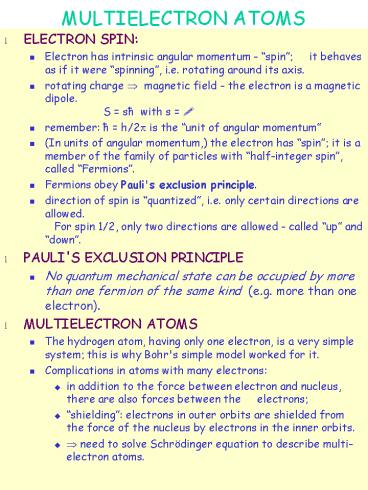MULTIELECTRON ATOMS - PowerPoint PPT Presentation
Title:
MULTIELECTRON ATOMS
Description:
ms= sz, the spin quantum number. Meaning of quantum numbers: ... collection of orbitals with same n: 'electron shell'; shells named K,L,M,N, ... – PowerPoint PPT presentation
Number of Views:24
Avg rating:3.0/5.0
Title: MULTIELECTRON ATOMS
1
MULTIELECTRON ATOMS
- ELECTRON SPIN
- Electron has intrinsic angular momentum -
spin it behaves as if it were spinning,
i.e. rotating around its axis. - rotating charge ? magnetic field - the electron
is a magnetic dipole. S sh with s ? - remember h h/2? is the unit of angular
momentum
- (In units of angular momentum,) the electron has
spin it is a member of the family of particles
with half-integer spin, called Fermions. - Fermions obey Pauli's exclusion principle.
- direction of spin is quantized, i.e. only
certain directions are allowed. For spin
1/2, only two directions are allowed - called
up and down. - PAULI'S EXCLUSION PRINCIPLE
- No quantum mechanical state can be occupied by
more than one fermion of the same kind (e.g.
more than one electron). - MULTIELECTRON ATOMS
- The hydrogen atom, having only one electron, is a
very simple system this is why Bohr's simple
model worked for it. - Complications in atoms with many electrons
- in addition to the force between electron and
nucleus, there are also forces between the
electrons - shielding electrons in outer orbits are
shielded from the force of the nucleus by
electrons in the inner orbits. - ? need to solve Schrödinger equation to describe
multi-electron atoms.
2
QUANTUM NUMBERS
- Schrödinger equation applied to atom ?
- electron's energy, magnitude and direction of
angular momentum are quantized (i.e. only certain
values allowed) - no well-defined orbit, only probability of
finding electron at given position orbital - the state of an electron is described by a set of
four quantum numbers - n, the principal quantum number
- l , the orbital quantum number
- ml lz, the orbital magnetic quantum number
- ms sz, the spin quantum number
- Meaning of quantum numbers
- the energy level of a state is determined by n
and l - most probable value of distance grows with n
- n 1,2,3,.
- l 0,1,2,3,, n -1 (i.e. n different values)
measures magnitude of angular momentum in
units of h value of l influences the energy and
the shape of the orbital - l 0 spherical
- l 1 dumbbell shaped,....
- ml 0, ?1, ?2, ? l , i.e. (2 l 1) different
values specifies direction of angular momentum
(gives component of angular momentum vector in
specified direction) ? determines orientation of
orbital - ms ? ? denotes direction of spin ms ?
spin up ms ? ? spin down
3
orbitals
- Orbital shapes
4
Electron shells
- Some definitions
- collection of orbitals with same n electron
shell shells named K,L,M,N,.. - one or more orbitals with same n and l
subshell - spectroscopic notation for orbitals orbitals
denoted by value of n and a letter code for the
value of l - l 0 s
- l 1 p
- l 2 d
- l 3 f
- l 4 g
- and alphabetic after that
- e.g. 2s refers to the subshell n2, 0
- number of electrons in the subshell is added as
a superscript - e.g. 2p6 means a configuration where 6
electrons are in the subshell 2p, i.e the
subshell with n 2 and l 1. - PAULI EXCLUSION PRINCIPLE ?
- No two electrons in the same atom can have the
same set of four quantum numbers - ? the number of electrons in a given subshell is
limited to 2x(2l 1) (factor of 2 is due to
orientation of spin), - number of electrons in a given shell is limited
to 2n2 . - ? in multi-electron atom, electrons cannot all
sit in the lowest energy levels.
5
Electron configurations of the elements
- Periods 1,2, 3, 4
- period 5
6
Electron configuration, contd
- Period 6
7
Electron configuration, contd
- Period 7































